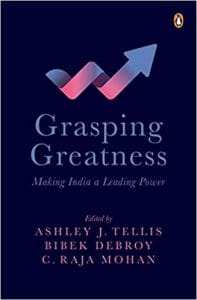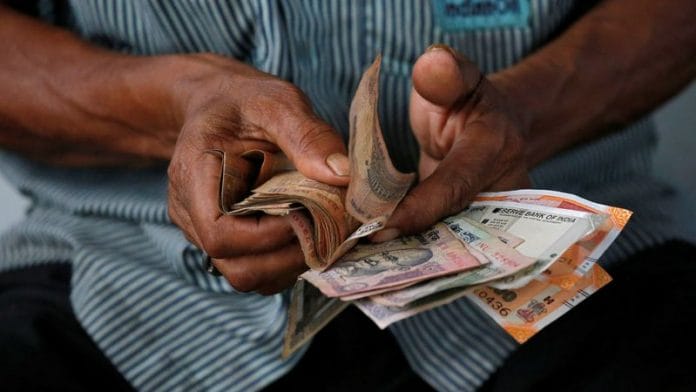There are gaps and limitations in analysing aggregate savings using macroeconomic data available through the National Account Statistics. An alternative approach to analyse the Indian household savings landscape is to look at the aggregated stock of savings (wealth). This captures decades of savings decisions and highlights households’ social and cultural preferences. The Household Finance Committee made some observations on the Indian household savings landscape:
1. The reports find that a large fraction of the wealth of Indian households is in the form of physical assets. In India, the average household holds 77 per cent of its total assets in real estate, 7 per cent in other durable goods (such as transportation vehicles, livestock and poultry, agricultural machinery and non-farm business equipment), 11 per cent in gold and the residual 5 per cent in financial assets (such as deposits and savings accounts, publicly traded shares, mutual funds, life insurance and retirement accounts). This is in contrast to developed economies, where households hold a substantial portion of their wealth in financial assets.
2. The objective of supporting consumption smoothing across the life cycle is served through old-age pension programmes. However, retirement assets play a very limited role, even for households at the top of the wealth distribution. This feature is not unique to India. Emerging economy households store a large proportion of their assets in physical assets. Financial assets account for a negligible proportion of total household assets. Within the class of financial assets, retirement accounts are virtually absent. While on the one hand the design of financial supply of such services has not kept pace with the demand for customization arising from households’ unique needs, large rural/agricultural populations, and large informal-sector workforces, additionally explain the low coverage of defined
pension programmes in emerging economies.
3. For households in the top quintile of wealth holdings, financial assets only play a relatively modest role, even for the wealthiest Indians. A large fraction of the wealth of young households is in the form of durable goods and gold, and as they approach retirement, most of their wealth is in the form of land and housing. There is a substitution effect between durable goods, gold and real estate such that the total share of physical assets remains relatively fixed.
These observations highlight concerns about the state of financial resources available for investment in the economy. Recognizing the low participation of households in financial assets, policy measures have been initiated towards improving access to banking for the
unbanked. In August 2014, the government announced the Pradhan Mantri Jan-Dhan Yojana (PMJDY) scheme to combat black money in the economy and provide 75 million unbanked Indians with zerobalance bank accounts, including access to a full range of financial services, including pension, credit and insurance. Between 2014 and 2018, the proportion of the financially included population grew from 54 per cent to 81 per cent. The Global Findex Report by the World Bank noted that the government’s thrust towards financial inclusion increased the number of account holders in India from 53 per cent in 2014 to 80 per cent in 2017. But the report also stated that a sizeable proportion of these accounts were dormant. In March 2017, 40 per cent of the accounts opened under the PMJDY were inoperative.10 The share of inoperative accounts has dropped to 18
per cent as of 15 January 2020.
Also read: India’s survival was important for US in 1950s. How it changed 40 years later
The above discussion shows that while access to bank accounts has shown a steady improvement, its active usage was a challenge in the initial years of the scheme. Even as on January 2020, one in every fifth Jan-Dhan account was inoperative. Despite a parallel policy push towards internet connectivity and digital literacy, the proportion of the Indian population accessing bank accounts through their phones or the internet is significantly lower than in other developing economies. For example, while people in African countries are moving towards financial inclusion and capitalizing on the growth of digital finance, the same cannot be said for India. People in rural areas are not comfortable using phones for banking. Poor access to electricity and internet penetration is also a contributory factor towards the slow adoption of digital banking.
While deposits constitute the bulk of household financial savings, there is considerable variation in the relative shares of various instruments over the last six decades. The share of currency has declined, reflective of the spread of banking facilities. The share of provident and pension funds has also consistently dropped till 2010, according to the report of the Planning Commission 2012.12 The share of life insurance funds has declined in the 2011–20 period.
Bank deposits constitute the bulk of household financial savings, though its share in the overall household financial savings has seen a dip from 2013–14 onwards. In the pre-demonetization year, 57 per cent of the financial savings were in cash and deposits, leaving a very small portion of savings in long-term savings. Shares and debentures constituted a small part of the overall financial savings of households. Investments in provident and pension funds saw a gradual rise, though they still constituted a small proportion of the overall savings. This pattern got disrupted in the demonetization year. In 2016–17, savings in currency were negative, as demonetization forced households to park their cash holdings with banks. The share of deposits in the overall household financial savings surged to more than 60 per cent in that year. In 2017–18, with the introduction of new currency notes, the share of currency holdings moved towards normalcy. The share of deposits dropped to around 26 per cent in the post-demonetization year. Since 2018–19, the share of deposits has stabilized to around 38 per cent. The share of insurance and pension and provident funds has moderated after surging in the demonetization year to around 22 per cent and
20 per cent, respectively.
Insurance and pension penetration are low by international standards. Pension funds’ assets are defined as assets bought with the contributions to a pension plan for the exclusive purpose of financing pension plan benefits. The pension fund is a pool of assets forming an independent legal entity. India lags behind not only advanced economies but is also placed after emerging economies in pension funds penetration. Pension funds’ assets as a per cent to GDP is less than 2 per cent as per the latest data.
India significantly trails other countries in insurance penetration. The life and non-life insurance premium income formed 2.82 per cent and 0.94 per cent of GDP respectively in 2019. This is low compared to the global average of 3.35 per cent and 3.88 per cent respectively. We attempt to estimate the time it would take for India to reach the current level of global average insurance penetration. Assuming the present average growth of insurance penetration in India, it would take us approximately twenty years to catch up with the global average.
The above discussion shows that the main challenge is not the unavailability of savings, but the composition of savings and the intermediation to channel savings into investment. India’s savings rate exceeds that of advanced economies such as the U.K., U.S. and similarly placed economies like Brazil and South Africa.
 This excerpt from Ila Patnaik and Radhika Pandey’s essay in ‘Grasping Greatness’, edited by Ashley J. Tellis, Bibek Debroy, and C. Raja Mohan has been published with permission from Penguin Viking.
This excerpt from Ila Patnaik and Radhika Pandey’s essay in ‘Grasping Greatness’, edited by Ashley J. Tellis, Bibek Debroy, and C. Raja Mohan has been published with permission from Penguin Viking.






